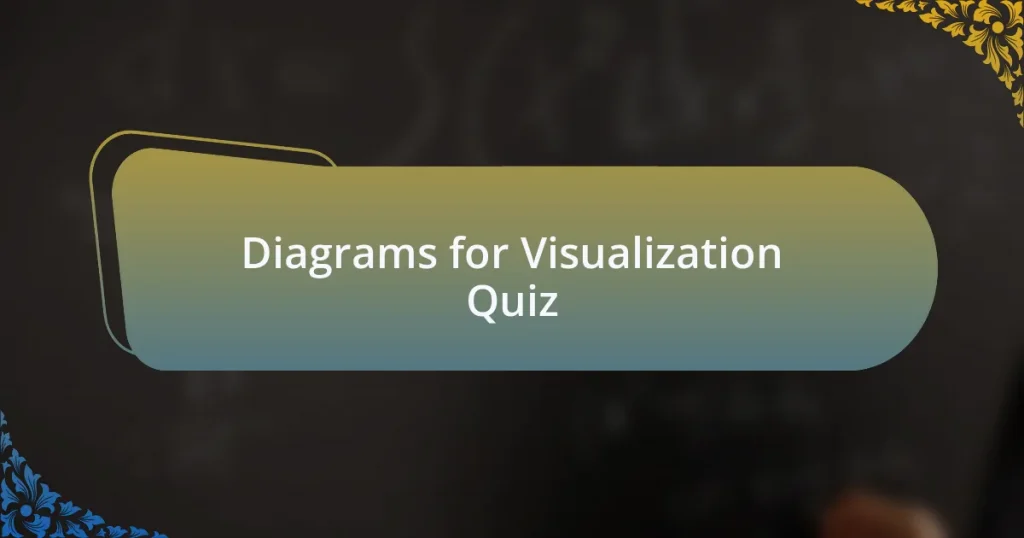Start of Diagrams for Visualization Quiz
1. What is an area chart used for?
- To show the relationships between two variables.
- To display categorical data without values.
- To visualize the change in volume over time.
- To compare static data across different categories.
2. What is a stacked area chart used for?
- To visualize the evolution of multiple data series over time.
- To show a single data point at a specific moment in time.
- To represent data in a tabular format for analysis.
- To analyze the relationship between two variables in a scatter plot.
3. What is a stream graph used for?
- To represent the distribution of a single variable across a population.
- To show changes in temperature over time as a line.
- To display points in a three-dimensional space for analysis.
- To visualize different values around a central baseline, creating a river-like stream.
4. What is a bump chart used for?
- To represent changes in a process flow.
- To display parts of a whole.
- To visualize data distribution categories.
- To show rankings over time.
5. What is a density plot used for?
- To compare discrete values in different categories.
- To illustrate the relationships between multiple categorical variables.
- To display the total change of data sets over intervals.
- To visualize how numeric data is distributed over time.
6. What is a ridgeline plot used for?
- To show the distribution of a numeric value for several groups of a category.
- To display changes over time in a single data series.
- To visualize the frequency of values across a single group.
- To compare the absolute values of different categories.
7. What is a horizon chart used for?
- To calculate the potential energy of an object in motion.
- To show time series data on the horizontal axis with colored bands representing values on the vertical axis.
- To illustrate the speed of a moving object in a given timeframe.
- To compare different forces acting on an object at rest.
8. What is a chord diagram used for?
- To illustrate the background of celestial bodies in space.
- To show the structure of paired connections between instances of the same level.
- To calculate the gravitational force between two masses.
- To represent the motion of particles in a fluid environment.
9. What is an arc diagram used for?
- To display frequencies of data within specific ranges.
- To represent quantities in a process as a series of stages.
- To visualize the change in temperature over time.
- To show connections between points on a line axis with arcs representing different aspects of the connection.
10. What is a Sankey diagram used for?
- To illustrate the properties of solid materials using graphs.
- To demonstrate the behavior of gases at different temperatures.
- To display flows from one set of values to another, showing entities connected by links with varying heights and colors.
- To represent the motion of objects in classical mechanics.
11. What is a doughnut chart used for?
- To illustrate the spectrum of colors in a visual representation of data.
- To display trends of multiple variables on a single axis over time.
- To compare physical measurements among unrelated data sets.
- To show the relationship of parts to a whole with a blank center for a label or icon.
12. What is a funnel chart used for?
- To represent time series data in a horizontal format.
- To show categorical comparisons among different groups.
- To visualize a process with stages, showing items flowing sequentially from one stage to the next.
- To display individual data points in a scatter format.
13. What is a gauge chart used for?
- To show progress toward a goal with a circular arc and shading representing progress.
- To represent complex data sets using multi-dimensional graphs.
- To illustrate the phases of a cyclical phenomenon.
- To compare different scientific theories in a visual format.
14. What is a ribbon chart used for?
- To show which data category has the highest rank (largest value) with the highest range displayed on top for each time period.
- To illustrate the average value of a dataset over time.
- To compare the size of different datasets side by side.
- To depict the relationship between two quantitative variables.
15. What is a treemap used for?
- To show the flow of energy through a circuit.
- To display large amounts of hierarchical data with colored rectangles representing values and their proportions.
- To illustrate the motion of particles in a field.
- To depict gravitational forces between objects.
16. What is a waterfall chart used for?
- To display the distribution of probabilities between categories.
- To visualize how an initial value is progressively affected by positive and negative values to reach a subtotal.
- To show changes in rankings over multiple categories.
- To compare the size of different data sets using bar lengths.
17. What is a line chart used for?
- To show changes in value across continuous measurements, such as those made over time.
- To analyze the distribution of a set of values.
- To display a process flow or sequence of steps.
- To compare the proportions of different categories.
18. What is a scatter plot used for?
- To show trends in a single set of data points.
- To visualize numerical data in hierarchical levels.
- To display correlations between two quantitative variables.
- To represent multiple categories in a stacked format.
19. What is a box plot used for?
- To summarize the distribution of values within measured groups using boxes and whiskers.
- To compare quantities of related data categories among one another.
- To display relationships between two categorical variables using points.
- To visualize changes in value across continuous measurements over time.
20. What is an area graph used for?
- To illustrate two-dimensional relationships between values.
- To display individual data points without trends over time.
- To show how a total has changed over time, including how its components’ contributions have changed.
- To summarize a single data value from various categories.
21. What is a dual-axis chart used for?
- To overlay two different charts with a shared horizontal axis but potentially different vertical axis scales.
- To show proportions of parts to a whole in a circular format.
- To depict data frequencies within a specific range using bars.
- To compare multiple groups using individual bars for each category.
22. What is a bubble chart used for?
- To show the relationship between three variables, using points with different shapes or colors to indicate group membership.
- To display the correlation between two variables on a single axis.
- To represent the distribution of a single variable using a line.
- To illustrate changes in data over time with bars stacked vertically.
23. What is a heatmap used for?
- To illustrate temperature changes in a 3D space.
- To depict the motion of particles over time.
- To show relationships in a linear graph format.
- To present a grid of values based on two variables of interest, with grid cells colored based on value.
24. What is a pie chart used for?
- To illustrate changes in data over time using vertical lines.
- To show correlations between two sets of data variables.
- To compare quantities of different categories along a single axis.
- To display parts of a whole, showing how a chosen data group can be categorized using characteristics that differ among them.
25. What is a bar graph used for?
- To compare quantities of related data categories among one another.
- To show the relationship between two variables using dots.
- To illustrate a single data point over time.
- To visualize how data is distributed within a group.
26. What is a bullet chart used for?
- To display a sequence of steps in a process.
- To show relationships between multiple datasets over time.
- To compare current progress against a target goal, especially useful when space is limited.
- To represent data distribution across different categories.
27. What is a flow chart used for?
- To display steps in a process using arrows, labels, and text boxes of varying shapes.
- To summarize the findings of a scientific experiment.
- To calculate the average of a set of data points.
- To measure the speed of an object in motion.
28. What is a histogram used for?
- To represent proportions of a whole in a circular format.
- To show changes in value across continuous measurements.
- To display the distribution of frequencies over intervals.
- To visualize three variables using different-sized circles.
29. What is a pictograph used for?
- To compare the increases and decreases of a value over time as bar heights.
- To show the relationship between two numeric variables with dots.
- To represent temperature changes over time using color gradients.
- To visualize data using images with a key explaining the value of each image.
30. What is a one-line line graph used for?
- To compare static data across categories.
- To display data in a circular format.
- To visualize multiple variables simultaneously.
- To track the change in a variable over time.
Quiz Completed Successfully!
Congratulations on completing the quiz on Diagrams for Visualization! You’ve taken an important step in enhancing your understanding of this crucial aspect of physics test preparation. Throughout the quiz, you may have discovered how diagrams can simplify complex concepts, making them easier to grasp and remember. Understanding the various types of diagrams, such as free-body diagrams and circuit diagrams, can significantly aid in solving physics problems more effectively.
Many of you might have learned the importance of visual representations in understanding relationships between forces, motion, and energy. Diagrams not only clarify abstract ideas but also serve as useful tools for organizing your thoughts during both study sessions and exams. By integrating diagrams into your study routine, you can improve your retention and application of physics concepts.
Now that you have completed the quiz, we invite you to explore the next section on this page about Diagrams for Visualization. This resource will expand your knowledge further and provide you with practical techniques to apply these diagrams in your studies. Dive deeper into how visualization can enhance your learning experience and improve your performance in physics!
Diagrams for Visualization
Understanding Diagrams for Visualization in Physics
Diagrams for visualization in physics effectively represent concepts, processes, and relationships. They simplify complex ideas, making them easier to grasp. For example, a free body diagram illustrates the forces acting on an object, highlighting equilibrium and motion. This visual clarity aids in problem-solving, especially in physics test preparation.
Types of Diagrams Commonly Used in Physics
Several types of diagrams are prevalent in physics, each serving a specific purpose. Common ones include free body diagrams, circuit diagrams, energy level diagrams, and wavefront diagrams. Free body diagrams showcase forces, while circuit diagrams depict electrical components and their connections. Energy level diagrams illustrate transitions between energy states, helping with quantum mechanics concepts.
Benefits of Using Diagrams for Problem Solving
Diagrams enhance problem-solving skills by providing a visual representation of information. They clarify relationships between variables and highlight relevant data. For instance, using a velocity-time graph allows students to visually analyze motion equations, facilitating quicker comprehension. This practice leads to improved retention and understanding during physics tests.
Creating Effective Physics Diagrams for Test Preparation
Creating effective physics diagrams involves clarity, accuracy, and appropriate labeling. Each component of the diagram must be visible and correctly represented. For example, when drawing a projectile motion diagram, include axes, trajectories, and important angles. Well-crafted diagrams direct focus to essential information, aiding students in study sessions and exam situations.
Common Mistakes When Using Diagrams in Physics Exams
Common mistakes include neglecting labels, misrepresenting scales, and overlooking key details. A diagram lacking labels can lead to confusion about forces or directions. Misrepresented scales can cause inaccuracies in interpretation. These errors can affect overall understanding, negatively impacting performance on physics tests. Being vigilant in these areas is crucial for success.
What are diagrams for visualization in physics test preparation?
Diagrams for visualization in physics test preparation are graphical representations that depict physical concepts, phenomena, and relationships. These diagrams help learners understand complex ideas by simplifying them into visual formats. Common examples include free-body diagrams, vector diagrams, and circuit diagrams. Research shows that using diagrams enhances spatial reasoning skills, which are crucial in physics.
How do diagrams aid in understanding physics concepts?
Diagrams aid in understanding physics concepts by providing a visual context that complements textual explanations. They allow students to visualize relationships between different variables, making abstract concepts more tangible. Studies have indicated that visual aids can significantly improve comprehension and retention of physics material, enhancing overall test performance.
Where can students find useful diagrams for physics study?
Students can find useful diagrams for physics study in textbooks, online educational platforms, and academic websites dedicated to physics. Many universities also provide supplemental materials that include diagrams. Additionally, resources like Khan Academy and HyperPhysics offer interactive diagrams that students can manipulate for better understanding.
When should students use diagrams during their physics preparation?
Students should use diagrams during their physics preparation whenever they encounter new concepts, especially those involving forces, motion, or energy interactions. Incorporating diagrams in study sessions helps clarify thoughts and identify misunderstandings. A systematic approach, such as using diagrams in problem-solving processes, has been shown to enhance efficiency in learning.
Who benefits from using diagrams in physics test preparation?
Both students and educators benefit from using diagrams in physics test preparation. Students gain improved understanding and retention of material. Educators can utilize diagrams to clarify tough concepts during instruction, leading to increased student engagement. Research indicates that all learners, regardless of their initial skill level, improve their grasp of physics through diagrammatic representations.















